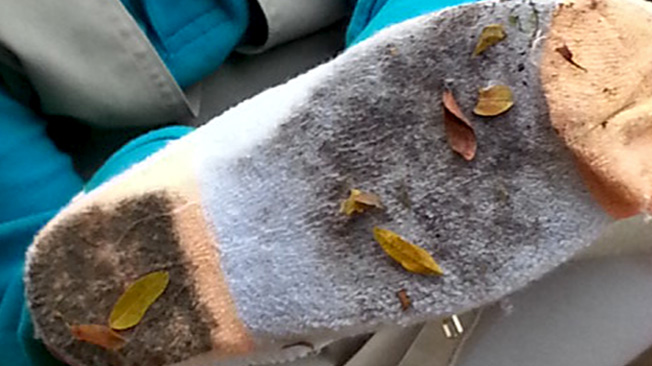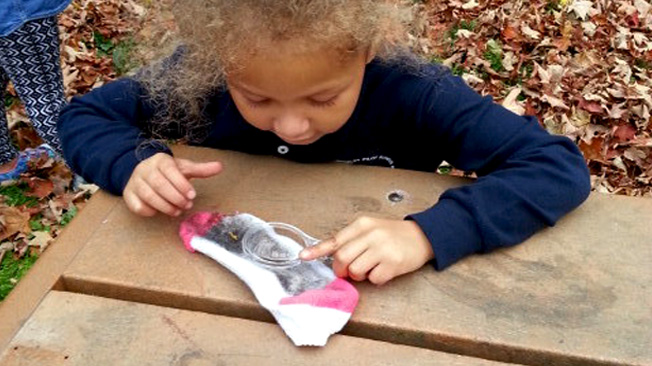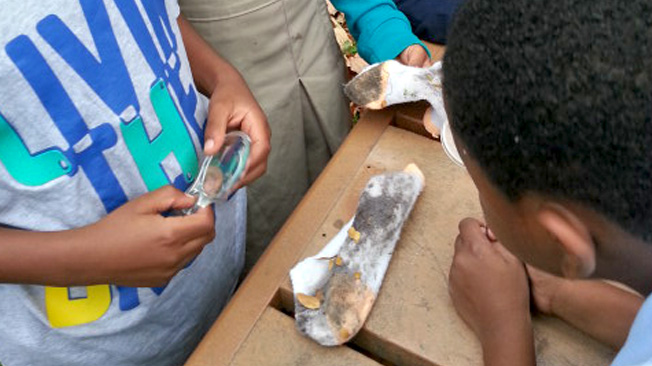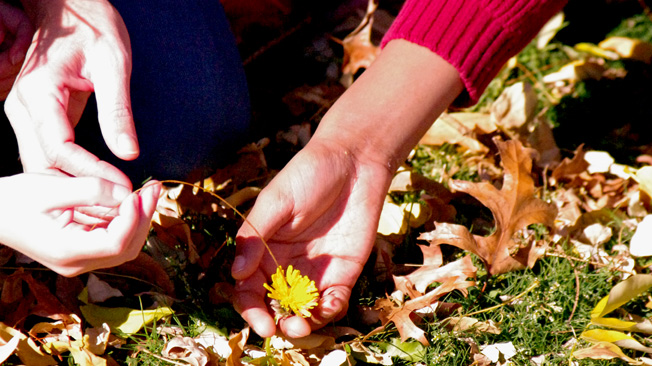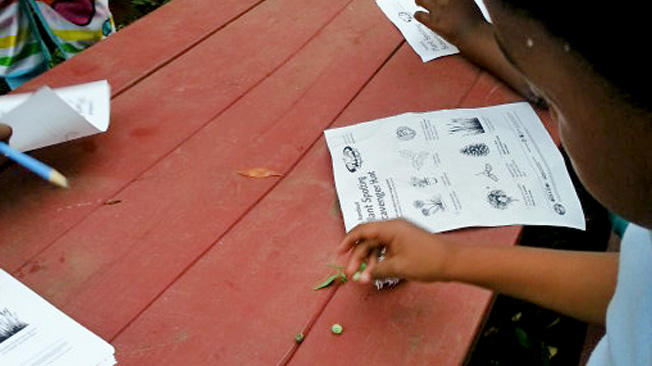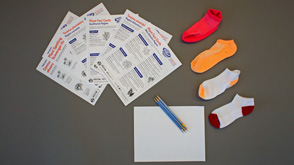Seed Travels
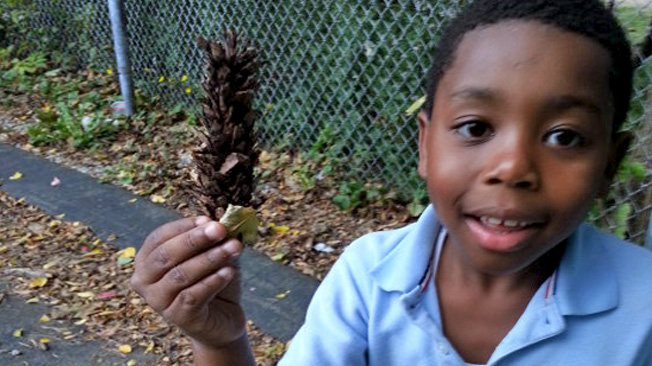
What Is This Activity?
How and why do some plants spread lots of seeds? Kids search for and observe a variety of local plants and seeds on a guided walk.
Introduction
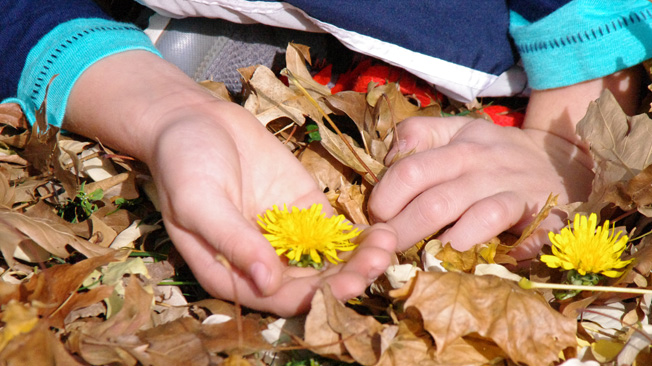
Learning Goals
Big Science Ideas:
- Plants can't move on their own. They depend on wind, water, animals, and explosive forces to carry their seeds to new places where they can sprout and grow.
Skills kids will use to investigate the ideas:
- Investigate seeds and other things in the soil
- Observe, document, and compare local plants to explain where, how, and why they spread their seeds to new locations
- Discuss solutions to a seed dispersal challenge
How Do You Get Ready?
- Read the activity and gather the materials.
- Look through all of the "Plant Fact" cards for ones that suit your region; print and cut out all that apply. Laminate them, if desired, or use clear contact paper or shipping tape.
- Make one copy of "Plant Spotting Scavenger Hunt" handout for each kid.
- Scout out a green space such as your program's yard, a park, or a playground.
- Troubleshoot any safety concerns (traffic, poison ivy, sharp objects, etc.).
- Plan to skip the warm-up activity if the ground is frozen or snowy.
- If you don't plan to show the "Plant Your Socks!" video that is paired with this activity on the website, watch it ahead of time and jot down concepts to share with kids during the activity.
Warm-up 10 minutes
(Science Skills: Investigate seeds and other things in the soil)
Hitch a Ride! Kids wear fuzzy socks and run around dirt or grass to collect seeds that hitch a ride, as they do on animal fur. Note that seeds are generally more plentiful from summer to late fall in most areas, but the activity can work in most seasons as long as the ground isn't frozen or snowy. (See "Explore Some More" to extend this activity.)
- Give each kid a sock to put over one of their shoes, fuzzy side out.
- Explain that fuzzy socks are like animal fur; seeds cling to them.
- Discuss: Are animals helping or hurting plants by catching their seeds? (Helping—this spreads the seeds so that plants can grow in new areas.) Where are you likely to find seeds in your area? (Explain that even patches of bare dirt can have seeds—especially weed seeds.)
- Have kids run, hop, and skip around your program yard or a green space for four or five minutes.
- Ask them to carefully remove the sock. What did their socks collect? Have them use hand lenses to look more carefully at the seeds, if available.
Activity 30-40 minutes
Plant Spotting
(30-40 minutes)
(Science Skills: Observe, document, and compare local plants to explain where, how, and why they spread their seeds to new locations)
- Point to a common tree and ask: How did it get there? Do you see others of the same kind nearby? Are the trees related—like family? Can a tree have a parent or a child? Can trees ever move to a new spot or are they stuck in one place for life? What would that be like? (Listen for ideas and revisit these questions after the nature walk.)
- Briefly discuss the variety of plant life in your region. Ask for volunteers to take turns reading aloud a few of the "Plant Facts Cards." Point out that none of these plants can move from place to place. So how do they spread and grow in new areas? (Plants don't move, but their seeds do!) Have your kid readers read and share the information on seeds from the cards again, if needed. (Seeds move with help from wind, water, gravity [fruit falling and rolling], digestion [birds eating berries and pooping out seeds], hitchhiking [sticking to animal fur], and even exploding!)
- Lead kids on a 15- to 20-minute walk through your area to spot the plants and seeds on the "Plant Spotting Scavenger Hunt" handout.
- Tell kids to think about where the plants are growing and how they got there. Encourage kids to write or draw their observations in their notebook. They can also take photos, if camera is available.
- When you find seeds, ask kids to imagine how the seeds might have spread.
- Berries and other fruits have seeds. They travel inside animals that eat them, or they fall to ground.
- Many seedpods pop open with force, shooting their seeds a surprising distance.
- Each dandelion seed is attached to a tiny white "parachute" that drifts in the wind.
- Wing-shaped seeds twirl like helicopters away from the parent tree.
- Some pinecones (the "female" ones) have seeds tucked into the scales. The cones fall and roll or, because they float, are carried away by water. The cone later dries up and opens, freeing the seeds.
- Grass seed is spread by wind or planted by people.
- Discuss: Why do some plants spread their seeds so far? What if they just let them drop? (If baby plants grow near their parents, the plants will compete for sun, water, and nutrients.) Why do plants produce so many seeds? (Not all seeds end up in a habitat in which they can sprout and grow, especially in a heavily paved area.)
Wrap-up 10 minutes
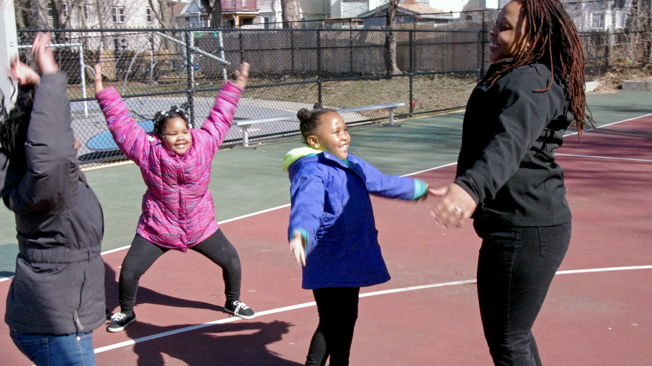
(Science Skills: Discuss solutions to a seed dispersal challenge)
Gather the group together and take a guided tour of each pair's habitat.
- Discuss: Did anything surprise you today?
- Be a tree: Tell the kids they are going to pretend to be trees dispersing seeds. Have everyone (including yourself) stand perfectly still with arms raised like the branches of a tree. Ask: If you were a tree, how would you spread your seeds far and wide? Review the methods: Wind, water, gravity [fruit falling and rolling], animal digestion, hitchhiking, and exploding!) Tell the kids to pick one method to model.
- If you haven't already, send home the "Explore Plants Around You" handout to provide families with ideas on how to continue investigating plants together.
Explore Some More
Plant Sock Seeds
If kids did the "Hitch a Ride!" warm-up activity, they can plant and grow the seeds they collected! Have them:
- Add potting soil to the bottom of a small plastic cup.
- Shake or pull off a few seeds from their socks and place them on a piece of paper.
- Examine them with a hand lens, if available.
- Place the sock in the cup with the seed side facing up. Sprinkle seeds examined on top of the sock.
- Cover with a little more soil and water them just enough to make the soil moist.
- Take the cups home and water when needed to keep soil moist.
- Watch what sprouts! It takes about a week or so. Encourage kids to report their results and, if possible, take a picture to share.
Seed Racer
Play the online Plum Landing game Seed Racer, in which Plum explains how plants spread their seeds to new places using wind, water, and animals. Plum then challenges kids to collect a variety of seeds over a series of timed missions. Encourage kids to look for the fun facts that pop up as they play the game. Have them pay attention to how shape and other features of the seeds affect how they travel.
Explorer's Notebook
Use the template provided: Have kids write about and sketch one of the plants they saw today. They can refer to their notes, sketches, and photos from the plant-finding activity or choose a new plant in your outdoor space. Guiding questions:
- How many leaves does the plant have? What shape and color is it? Does it have flowers? Seeds? How do you think its seeds spread to new places?

